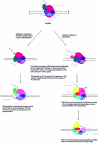Cockayne syndrome group B cellular and biochemical functions
- PMID: 14639525
- PMCID: PMC1180389
- DOI: 10.1086/380399
Cockayne syndrome group B cellular and biochemical functions
Abstract
The devastating genetic disorder Cockayne syndrome (CS) arises from mutations in the CSA and CSB genes. CS is characterized by progressive multisystem degeneration and is classified as a segmental premature-aging syndrome. The CS complementation group B (CSB) protein is at the interface of transcription and DNA repair and is involved in transcription-coupled and global genome-DNA repair, as well as in general transcription. Recent structure-function studies indicate a process-dependent variation in the molecular mechanism employed by CSB and provide a starting ground for a description of the mechanisms and their interplay.
Figures




References
Electronic-Database Information
-
- Online Mendelian Inheritance in Man (OMIM), http://www.ncbi.nlm.nih.gov/Omim/ (for CS, CSB, XPC/hHR23B, RPA, XPA, XP, XPB, XPD, XPE, XPF/ERCC1, XPG, TFIIH, APE1, RNA polymerase I, RNA polymerase II, RNA polymerase III, CSA, XP/CS, cerebro-oculo-facio-skeletal syndrome, DeSanctis-Cacchione severe neurological form of XP, XPB/CS, XPD/CS, XPG/CS, p53, UNG, OGG1, ERCC6, JUN, hMSH2, hMLH1, U1, U2, 5S rRNA, TFIIS, Brg1, hBrm, PCNA, replication factor C, DHFR, p44 subunit of TFIIH, DDB1, Cul4A, Roc1, CSN, p62, TTD, Nth1, TAFII 250, TFIIE, SWI2/SNF2, TAF-172, RAD54, RAD5, CKII, protein phosphatase 1, CHRAC, TBP, CBP, and topoisomerase II)
References
-
- Balajee AS, May A, Dianova I, Bohr VA (1998) Efficient PCNA complex formation is dependent upon both transcription coupled repair and genome overall repair. Mutat Res 409:135–146 - PubMed
Publication types
MeSH terms
Substances
LinkOut - more resources
Full Text Sources
Other Literature Sources
Medical

